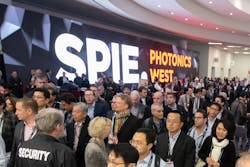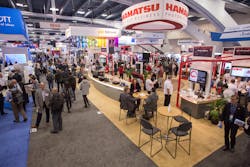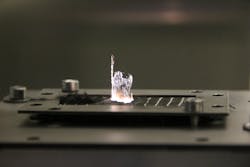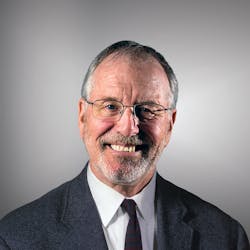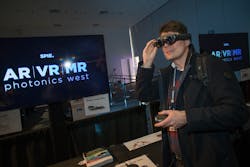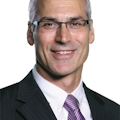SPIE Photonics West 2020 brings laser, optics, and photonics technologies into focus for the future
“With our estimated 23,000 attendees, 1400 exhibitors, and over 5000 technical presentations, we are looking forward to setting new records at SPIE Photonics West in 2020, and confirming its position as the world’s leading annual optics and photonics conference and exhibition,” says Andrew Brown, SPIE Senior Director of Global Business Development. “I’m particularly looking forward to our exciting and ever-expanding industry program, which this year amounts to more than 60 dedicated events over six days and includes a new partnership with Endeavor Business Media.”
At the Moscone Center in San Francisco, attendees will have access to more than 5200 technical papers, 65 courses and workshops, plenary speakers, an expanded industry program, and numerous networking events. Photonics West 2020 combines two major international exhibitions (BiOS Expo and Photonics West Exhibition) and three conferences (BiOS, LASE, and OPTO).
The conference will also host several special events, including the SPIE Startup Challenge, the Prism Awards, and the popular AR/VR/MR conference, which has been expanded to three days. And for those exploring career opportunities, the Job Fair will feature many of the industry’s leading companies in search of talented new employees.
Additionally, this event’s application tracks focus in on three key technologies:
- Brain/neuro research
- Translational research
- 3D printing
The conference kicks off with BiOS, the Biomedical Optics part of the symposium that takes place during the first weekend, with conference sessions beginning early in the morning on February 1, a day crowned by the Saturday night BiOS Hot Topics presentations, which never disappoints.
Meanwhile, the BiOS Expo exhibit hall opens the morning of Saturday, February 1 and runs through Sunday night. The expo will feature more than 200 companies showcasing their biomedical optics products, systems, and software. Featured technologies will include biomedical optics, lasers, molecular imaging, therapeutic lasers, nano/biophotonics, biosensors, and spectroscopic/microscopic imaging.
BiOS Conferences (see http://bit.ly/LFW-BIOS) will continue through Wednesday night. Conference program tracks will focus on:
- Photonic therapeutics and diagnostics
- Neurophotonics, neurosurgery, and optogenetics
- Clinical technologies and systems
- Tissue optics, laser-tissue interaction, and tissue engineering
- Biomedical spectroscopy, microscopy, and imaging
- Nano/biophotonics
LASE Symposium
LASE, the industrial laser, laser source, and laser application conference, will highlight such topics as laser source engineering, nonlinear optics, laser manufacturing, laser micro-/nanoengineering, 3D fabrication, and materials processing, among others. Technical conference tracks (see http://bit.ly/LFW-LASE) will include:
- Laser sources
- Nonlinear optics and beam guiding
- Micro/nano applications
- Macro applications
The LASE plenary session, held Monday afternoon, consists of a talk on vertical-cavity surface-emitting lasers (VCSELs) and two presentations concentrating on the use of lasers as the driving engines for miniature particle accelerators. In the first talk, Kenichi Iga of the Tokyo Institute of Technology, who is the inventor of the VCSEL, first gives a background on the development of these devices, and then delves into their upcoming use as a physical layer in artificial intelligence (AI) and Internet of Things (IoT) technology, as well as parallel optical interconnects, face-recognition systems, lidar, free-space laser-powered systems, and more. Franz X. Kärtner of Deutsches Elektronen Synchrotron (Germany) and the University of Hamburg then presents “Compact Terahertz Driven Electron and X-ray Sources” that include laser-based high-energy terahertz generation, terahertz guns, and accelerators. Last, Robert Nyer of Stanford University, which is a center for accelerator technology, gives a talk, “Accelerators on a Chip: A Path to Attosecond Science,” covering the latest advances in this field, including a prototype accelerator that fits into a shoe box, and the scientific studies this technology can inspire.
The LASE conference program is concentrated into four tracks: Laser Sources, Nonlinear Optics and Beam Guiding, Micro/Nano Applications, and Macro Applications.
Laser Sources, the bedrock conference track of LASE, is divided into five topics: Solid State Lasers XXIX: Technology and Devices, Fiber Lasers XVII: Technology and Systems, Components and Packaging for Laser Systems VI, High-Power Diode Laser Technology XVIII, and Vertical External Cavity Surface Emitting Lasers (VECSELs) X. Solid State Lasers, a vast topic in itself, includes subtopics such as eye-safe and mid-IR lasers, structured beams, novel laser concepts, pulsed lasers, laser materials, ultrafast lasers, and UV-VIS lasers.
Novel Laser Concepts should catch the interest of many in Laser Focus World’s audience. It includes talks on a diode-pumped, single-mode, narrow linewidth tunable vertical surface-emitting organic laser (VECSOL) controlled by a chirped volume Bragg grating (paper 11259-17), a narrow-linewidth tunable and dual-wavelength compact alexandrite laser (paper 11259-18), a Nd:YLF/KGW intracavity Raman laser emitting at 1147 and 1163 nm (paper 11259-19), and two talks on InnoSlab lasers (InnoSlab is a laser design that was developed at the Fraunhofer Institute for Laser Technology in Aachen, Germany in the 1990s, in which the laser amplifier slab crystal is longitudinally pumped): one covering a highly stable, high-power hybrid fiber and InnoSlab amplifier for narrow-linewidth signals (paper 11259-20), and the other on high-power ultrafast lasers based on InnoSlab technology (see Fig. 3), presented by researchers at Amphos (paper 11259-21).The UV-VIS lasers session, covering a topic of traditional interest to laser nerds, includes presentations on a 2 kW continuous-wave (CW) laser in the green wavelength regime for copper welding by authors at TRUMPF (paper 11259-56), a promising approach for a sodium guide-star laser—diamond Raman and intracavity second harmonic generation (paper 11259-57), multiple and selectable wavelength green laser generation based on coaxial diode-end-pumping (paper 11259-58), and a high-efficiency gallium nitride laser-diode pumped CW ruby laser (paper 11259-59). All four of these talks should provide the combination of coolness and novelty that a true laser jock covets.
OPTO Symposium
OPTO, the optoelectronics, photonic materials, and device conference, is set to cover topics including silicon photonics, photonic crystals, optoelectronics, semiconductor lasers, and nanophotonics, as well as quantum technologies for information, sensing, materials, and dots. Technical conference tracks (see http://bit.ly/LFW-OPTO) include:
- Optoelectronic materials and devices
- Photonic integration
- Nanotechnologies in photonics
- MOEMS-MEMS in photonics
- Advanced quantum and optoelectronic applications
- Semiconductor lasers and LEDs
- Displays and holography
- Optical communications (devices to systems)
- 3D printing
The three speakers at the OPTO plenary session, held Monday morning, each cover a topic that ties optics and photonic research to practical applications, both present and future. David Payne, director of the Optoelectronics Research Center at the University of Southampton, which could be the world’s most well-known locus for high-end fiber-optics research, gives a talk, “The Future of Optical Components and Materials in the Fibre,” in which he summarizes the major advances, including the erbium-doped fiber amplifier (EDFA) invented by Payne and his team in the 1980s, that have led to the present dominance of fiber optics in the long-haul data communications arena. Payne then discusses what is to come in fiber optics. Next, Erik Bakkers of the Eindhoven University of Technology describes a potentially large advance in light emitters: the creation of efficient silicon-based light sources using the addition of germanium to create a direct-bandgap semiconductor out of group IV materials. Finally, Trond Wuellner of Google presents “Product Design for the Next Wave of Computing,” in which he discusses the future of computing and how it relates to development of innovative products and technologies.
Topics of the many OPTO conference program tracks include Optoelectronic Materials and Devices, Photonic Integration, Nanotechnologies in Photonics, MOEMS-MEMS in Photonics, Advanced Quantum and Optoelectronic Applications, Semiconductor Lasers and LEDS, Displays and Holography, Optical Communications: Devices to Systems, and 3D Printing.
For example, Tuesday’s “Optical Components and Materials XVII” conference covers numerous types of micro- and macroscopic optical devices, as well as optoelectronic devices, including optical switches, optical modulators, plasmonic devices and technologies, photodetectors, rare-earth-doped lasers, optical properties of materials, lasers and amplifiers, sensors, nanoparticles, and nanostructures. For example, the Photodetectors session has talks on high-performance AlAsSb avalanche photodiodes (paper 11276-13), nanostructured germanium for near-infrared sensors with >99 % absorption up to 1600 nm (paper 11276-14), high-sensitivity near-IR photodiodes using black silicon (paper 11276-15), and other advances. The Sensors session includes presentations on high-sensitivity refractive-index sensing using an axicon lens (paper 11276-33), synthetic diamond lenses for IR and multispectral imaging (paper 11276-35), optical coherence tomography (OCT) measurement of aspheric polymer lenses for adaptive assembly of micro-optical imaging objectives (paper 11276-37), and others.
For those with a focus on optics, sessions on “Advanced Fabrication Technologies for Micro/Nano Optics and Photonics XIII,” held at various times from Sunday to Wednesday, cover topics including micro-optics, plasmonics, metasurfaces, and novel materials; 3D circuits and emitters; large-area optics; direct laser writing (DLW) relating to sensing and waveguides, structural colors, micro-optics and metals, and high-speed printing; advanced manufacturing using a digital micromirror device (DMD) or other spatial light modulator (SLM); and 3D lithography with DMD and SLM devices. The vital topic of metasurfaces is represented by talks on high-NA silicon metalenses for wide-field imaging (paper 11292-10), a 3D-printed miniature spectrometer (paper 11292-56), and others. The Large Area Optics topic includes presentations on microscope projection photolithography of functional polymeric optical micro- and nanocomponents (paper 11292-25), freeform microlens arrays: Current and future challenges (paper 11292-26), and direct nanoimprinted inorganic nanophotonics by Substrate Conformal Imprint Lithography (paper 11292-27), and more.
In another example, the “Gallium Nitride Materials and Devices XV” conference on Tuesday delves into all things gallium nitride, including laser diodes, VCSELS, LEDs, micro-LEDs, and nonlinear optics. One of today’s hottest topics is micro-LEDs—this subject is supported by talks on 3D GaN microstructures with high aspect ratio: from material properties to devices (paper 11280-43), local emission properties of micro-fin LED structures, novel micro-LED devices for visible and ultraviolet wireless optical communications (paper 11280-47), application of porous GaN for microLEDs (paper 11280-48), and photonic properties of micro/mini LED arrays with different substrate thicknesses (paper 11280-49).
BiOS Symposium
When the Biomedical Optics Symposium (BiOS) opens its first conference sessions the morning of Saturday, February 1, it will launch a spectacular showcase of technological and applications progress, in both the research and commercial realms. The conference tracks this year are biomedical optics, photonic therapeutics and diagnostics, neurophotonics, tissue engineering, translational research, tissue optics, clinical technologies and systems, biomedical spectroscopy, microscopy, imaging, and nano/biophotonics. As in recent past years, sessions appearing in these tracks may also be included in two “virtual tracks” covering Brain/Neuro Research and Translational Research.
A couple of hours after the conferences begin, the exhibit hall will open to facilitate connections between more than 200 exhibitors and their audiences for two full days (Saturday and Sunday, 10 a.m.–5 p.m.). New this year will be a range of industry sessions offered on the Industry Stage, in Hall DE right on the exhibit floor. Among these are Saturday sessions featuring new developments in optical coherence tomography (OCT) presented by key OCT innovators (10:30 a.m.–12:15 p.m. and organized by BioOptics World/Laser Focus World, incidentally) and the Healthcare Keynote ("Engineering the Future of Health") by Bruce Tromberg of NIBIB and NIH from 1:30 to 2 p.m. On Sunday, the Expo industry stage will feature Photonics in Healthcare chaired by Tom Harvey, Healthcare Photonics Lead at the CPI Centre for Healthcare Photonics (Sedgefield, England) and featuring commercial leaders (10:00 a.m.–12:00 p.m.), and then Artificial Intelligence in Medical Imaging (1:30–4:00 p.m.) chaired by Kyle Myers of the U.S. Food and Drug Administration. BiOS poster sessions will take place on Sunday and Monday, 5:30–7:00 p.m. (Moscone West, Level Three).
Hot Topics and other plenaries
A perennial highlight of the annual event is BiOS Hot Topics on Saturday, 7:00–9:30 p.m. (Room 206/214, South Level Two), which opens with a welcome by BiOS 2020 Symposium co-chairs Jennifer Barton (University of Arizona) and Wolfgang Drexler (Medical University of Vienna, Austria) and moves quickly to presentation of the latest Britton Chance Biomedical Optics Award, which, according to SPIE, recognizes outstanding lifetime contributions to biomedical optics through the development of innovative, high-impact technologies. This year’s recipient is Steven Jacques, currently an affiliate professor in the University of Washington's Department of Bioengineering (see Fig. 4). A founder of the field of biomedical optics, Jacques will follow the award presentation with a talk sure to demonstrate that he is as influential as he is unpretentious.Nine 10-minute presentations will follow, beginning with an overview of OCT by none other than James Fujimoto (Massachusetts Institute of Technology; Cambridge, MA), one of the technique’s discoverers and original developers. Then, Laura Waller (University of California, Berkeley) will speak on computational microscopy, and Sarah Bohndiek (University of Cambridge, England) will report on early cancer detection with light-based technology. Gabriel Popescu (University of Illinois at Urbana-Champaign) will deliver an update on progress involving quantitative phase imaging on multiple scales. Muyinatu A. Lediju Bell (Johns Hopkins University; Baltimore, MD) will discuss the use of photoacoustic imaging to facilitate minimally invasive surgeries and procedures, and Ewa Goldys (University of New South Wales, Australia) will provide Future Clinical Perspectives on the interface of radiation-optical interactions and nanotechnology. Bo Huang (University of California, San Francisco) will explain proteome imaging in living cells, while Shawn Chen (NIH/NIBIB) will report on x-ray induced photodynamic therapy. The application of artificial intelligence to cell sorting will conclude the evening in a presentation by Keisuke Goda (University of Tokyo, Japan).
Sunday will see two other biomedical optics plenaries. The Neurotechnologies Plenary, co-chaired by David Boas (Boston University; Boston, MA) and Elizabeth Hillman (Columbia University; New York, NY) and designed to highlight advances and facilitate communication and networking, will take place in the afternoon (3:30–5:30) and the second Sunday Plenary (7:15–8:00 p.m.) will feature 2014 Nobel Prize Winner Eric Betzig (University of California, Berkeley and the Howard Hughes Medical Institute; Chevy Chase, MD) reporting on the Secret Lives of Cells.
On Tuesday (10:30–11:30 a.m.), look for the Nano/Biophotonics Plenary, titled Plasmonics Nanoparticles for Use in Theranostics and delivered by Michel Meunier (Polytechnique Montréal, Canada).
And more
Biomedical optics-oriented technical events include two on Sunday: the 50th anniversary celebration of supercontinuum light (Sunday, 10:00 a.m.–5:15 p.m.) moderated by Angela Seddon (University of Nottingham, England) and featuring a range of speakers in addition to supercontinuum’s discoverer, Robert Alfano. A Q&A panel discussion titled New Horizons in Clinical Applications of Label-Free Imaging and Sensing (Sunday, 10:40 a.m.–12:20 p.m.) will be chaired by Oliver Hayden (Technische University München, Germany) and will feature key innovators Guillermo J. Tearney (Massachusetts General Hospital; Boston, MA), Jürgen Schnekenbürger (Westfälische Wilhelms-University of Münster, Germany), Pierre P. Marquet (CERVO Brain Research Center; Québec, QC, Canada) and Seemantini K. Nadkarni (Wellman Center for Photomedicine; Boston, MA).
If you’re looking for lunch on Sunday, check out the Translational Research Lunchtime Forum (12:30–2:00 p.m.), where boxed lunches will be given to the first 100 attendees. The session will feature a discussion of outcomes-based studies with life-changing potential selected from the Translational Research virtual symposium.
Translational Research virtual symposium
There are a whole lot of offerings related to the SPIE Startup Challenge, which this year features two tracks, one being photonics-enabled healthcare (see Fig. 5). The healthcare-oriented Startup Challenge Finals take place Wednesday, 9:00–11:30 a.m., and the awards and reception runs from 3:30 to 5:00 p.m. The Challenge is part of SPIE’s Entrepreneur Program and Venture Summit, which opens on Saturday with the introductory-level Think Like an Entrepreneur Workshop—Healthcare Focus (9:00 a.m.–12:00 p.m.). The workshop, under the direction of Farzin Samadani (National Instructor for I-Corps Program), brings experienced photonics entrepreneurs and specialists together with people who need to demystify the process of starting their own healthcare venture using light-based technologies.Of course, there is so much more, but just like the event itself, space and time keep me from reporting everything. No matter how you experience BiOS 2020, however, it is sure to supply you with plenty of inspiration. Enjoy!
AR/VR/MR
Co-located once again with Photonics West, the third annual augmented, virtual, and mixed reality conference offers attendees presentations and demonstrations from known industry names in consumer electronics and up-and-coming XR companies (see Fig. 6). The three-day event also includes a new technical program, invited industry talks, panel discussion, a student optical design challenge, courses, an expo and demonstrations, and networking opportunities.Event highlights
Whether attending Photonics West 2020 or just curious what the event has in store for this year, SPIE also compiled a list of the top 9 things to do while there:
1. Listen to plenary sessions and BiOS hot topics
2. Hear from the Prism Award winners
3. Check out the new Entrepreneur Program and Venture Summit
4. Hone your skills at the SPIE Career Summit
5. See the expanded SPIE AR, VR, MR event
6. Catch some of the equity, diversity, and inclusions events
7. Take a course from OCT co-inventor James Fujimoto
8. Hear Nobel Laureate Eric Betzig speak at the BiOS Plenary
9. See the Startup Challenge final pitches for healthcare and deep learning
And don’t forget, for those with a particular interest in the laser industry, Laser Focus World will once again present its 2020 Lasers & Photonics Marketplace Seminar on February 3rd at the Intercontinental, just down the street from the Moscone convention center. The Seminar features a keynote presentation from Akira Hiruma of Hamamatsu and a keynote discussion with John T.C. Lee of MKS Instruments, along with presentations on precision optics and high-power ultrafast lasers that are facilitating new innovations in photonics and driving laser sales.
Editor's Note: We also present a sneak peek at some of the products and technologies to be introduced and/or showcased at the Photonics West Exhibition that kicks off on February 4th (http://bit.ly/2u1sdiF).
About the Author
John Wallace
Senior Technical Editor (1998-2022)
John Wallace was with Laser Focus World for nearly 25 years, retiring in late June 2022. He obtained a bachelor's degree in mechanical engineering and physics at Rutgers University and a master's in optical engineering at the University of Rochester. Before becoming an editor, John worked as an engineer at RCA, Exxon, Eastman Kodak, and GCA Corporation.
John Lewis
Editor in Chief (2018-2021)
John Lewis served as Editor in Chief of Laser Focus World from August 2018 through October 2021, after having served as the Editor in Chief of Vision Systems Design from 2016 to 2018. He has technical, industry, and journalistic qualifications, with more than 13 years of progressive content development experience working at Cognex Corporation. Prior to Cognex where his articles on machine vision were published in dozens of trade journals, he was a technical editor for Design News, covering automation, machine vision, and other engineering topics, for over six years.

Barbara Gefvert
Editor-in-Chief, BioOptics World (2008-2020)
Barbara G. Gefvert has been a science and technology editor and writer since 1987, and served as editor in chief on multiple publications, including Sensors magazine for nearly a decade.
